Kyoto, the ancient capital of Japan, is famous for its rich history, breathtaking temples, and serene gardens. Whether you’re interested in history, culture, nature, or culinary experiences, Kyoto has something to offer every traveler. In this blog, we’ll take you to the top 8 beautiful areas to walk in Kyoto
Contents
Arashiyama Bamboo Grove
Nestled in the western outskirts of Kyoto, the Arashiyama Bamboo Grove is a place of enchantment, where nature and culture converge to create an unforgettable experience. This serene bamboo forest, also known as the Sagano Bamboo Forest, is a must-visit destination for anyone exploring the historical city of Kyoto, Japan
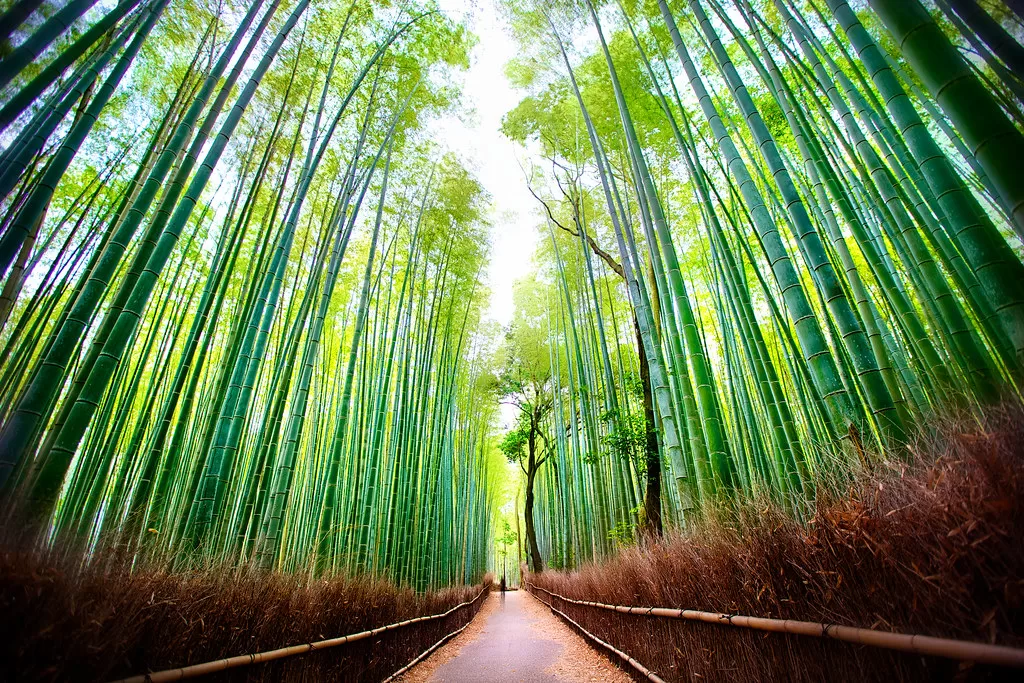
Address:
Ukyo Ward, Kyoto, 616-0007, Japan
How to Get There from Kyoto Station:
- Train:
The most convenient way to reach Arashiyama Bamboo Grove from Kyoto Station is by taking the JR Sagano Line to Saga-Arashiyama Station. The bamboo grove is within walking distance from the station, and the journey takes around 15 minutes. - Bus:
You can also take a bus from Kyoto Station to Arashiyama. Bus routes 28, 71, and 72 are commonly used for this route. The bus ride takes approximately 35-40 minutes. Get off at the Arashiyama-Tenryuji-mae bus stop.
Activities to Enjoy:
- Stroll Through the Bamboo Grove:
The main attraction, of course, is the bamboo forest itself. Take a leisurely walk along the Bamboo Forest Trail, a well-maintained path that guides you through the towering bamboo stalks. - Visit Tenryu-ji Temple:
Located near the bamboo grove, Tenryu-ji is a UNESCO World Heritage site and one of Kyoto’s most important Zen temples. Explore its beautiful garden and the historic temple buildings. - Togetsukyo Bridge:
Walk to the iconic Togetsukyo Bridge that spans the Hozugawa River. It offers picturesque views of Arashiyama and is especially beautiful during the cherry blossom and fall foliage seasons. - Monkey Park Iwatayama:
If you’re traveling with family or interested in wildlife, visit the Monkey Park Iwatayama, where you can see and feed Japanese macaques while enjoying panoramic views of Kyoto. - Enjoy Traditional Tea:
In Arashiyama, you’ll find charming tea houses where you can savor a cup of matcha (green tea) and some traditional Japanese sweets.
Best Times to Visit:
- Early Morning:
To experience the serene beauty of the bamboo grove in relative solitude, visit early in the morning when it’s less crowded. - Late Afternoon:
The late afternoon sun filtering through the bamboo creates a magical atmosphere. It’s an excellent time for photography. - Spring:
If you’re a fan of cherry blossoms, visit in late March or early April when the cherry trees lining the paths are in full bloom. - Autumn:
For vibrant fall foliage, the best time to visit is in November when the leaves turn shades of red, orange, and yellow.
Fushimi Inari Shrine
Fushimi Inari Shrine, dedicated to the Shinto deity Inari, has a history that dates back over a thousand years. Inari is considered the deity of rice, prosperity, and agriculture, and it is no surprise that Fushimi Inari is one of the most important and visited shrines in Japan. The shrine’s origins can be traced to the 8th century, and it has grown in popularity over the centuries.
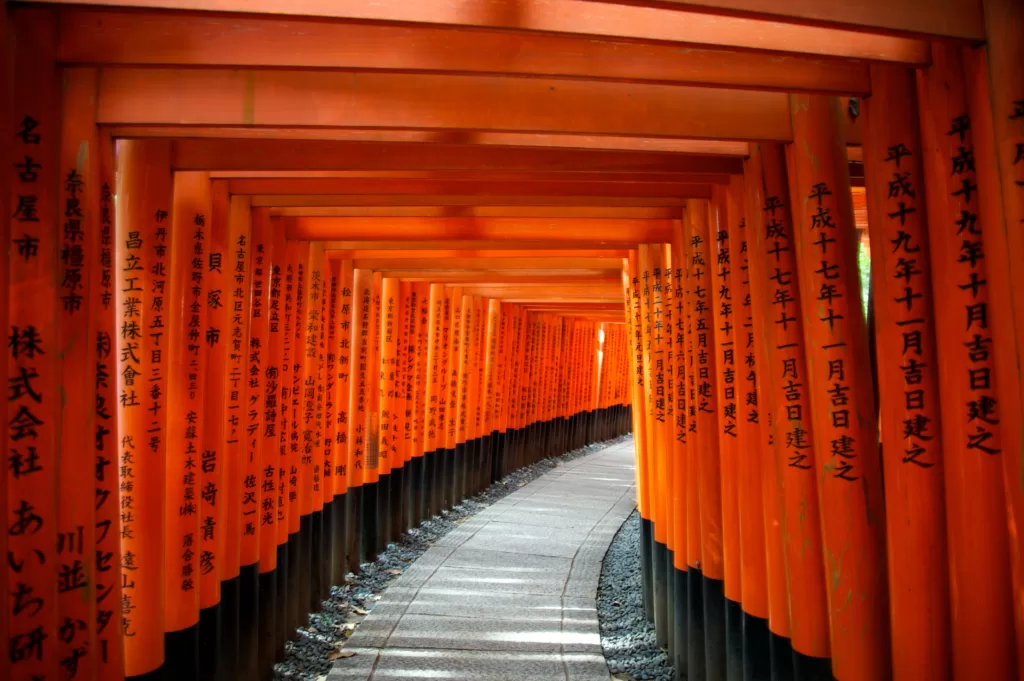
Address:
68 Fukakusa Yabunouchicho, Fushimi Ward, Kyoto, 612-0882, Japan
How to Get There from Kyoto Station:
- From Kyoto Station, head to the JR Nara Line (also known as the Nara Line). You can reach the JR Nara Line platforms from the main hall of Kyoto Station.
- Take a train bound for Inari Station. Fushimi Inari is the name of the station you need to get off at, but it’s often referred to as Inari Station.
- The journey from Kyoto Station to Inari Station takes approximately 5-7 minutes.
- Once you arrive at Inari Station, exit the station and follow the signs for Fushimi Inari Shrine. The entrance to the shrine is just a short walk away from the station.
- You’ll soon encounter the iconic red torii gates that mark the beginning of your visit to Fushimi Inari Shrine.
Activities to Enjoy:
- The Senbon Torii (Thousand Torii Path):
The most iconic feature of Fushimi Inari Shrine is the Senbon Torii, which means a thousand torii gates. In reality, there are far more than a thousand gates; it’s more like several thousand. The path takes you on a roughly 2.5-mile journey through a beautiful forested area up the sacred Mount Inari. - Fox Statues:
Foxes, specifically white foxes, are considered messengers of Inari. You’ll notice many fox statues (kitsune) around the shrine, often holding a symbolic key or a jewel in their mouths. - Main Shrine Buildings:
The main shrine buildings are found at the base of the hill, and you can pay your respects and make offerings here. Don’t forget to ring the bell to announce your presence to the deity. - Hiking:
If you’re feeling adventurous, you can continue your hike up the mountain, where you’ll find more serene areas, smaller shrines, and panoramic views of Kyoto. The hike takes around 2-3 hours round trip.
Best Times to Visit:
Fushimi Inari Shrine is a beautiful destination to visit year-round, but here are some considerations:
- Early Morning:
To avoid the crowds and experience the tranquility of the shrine, visit early in the morning. The shrine is open 24/7, so sunrise visits are possible. - Seasonal Beauty:
Spring cherry blossoms and fall foliage make for stunning photo opportunities, so consider visiting in late March to early April or in November. - Festivals:
Witnessing one of the shrine’s festivals, such as the New Year’s celebrations or the Setsubun Festival in February, can be a unique and memorable experience.
Gion District
Gion is one of Kyoto’s most famous and historic districts, known for its well-preserved machiya (traditional wooden townhouses), teahouses, and the presence of geisha and maiko (apprentice geisha). The district’s roots can be traced back to the Middle Ages when it emerged as a hub for entertainment and culture. Today, Gion remains an iconic symbol of Kyoto’s elegance and traditional charm.
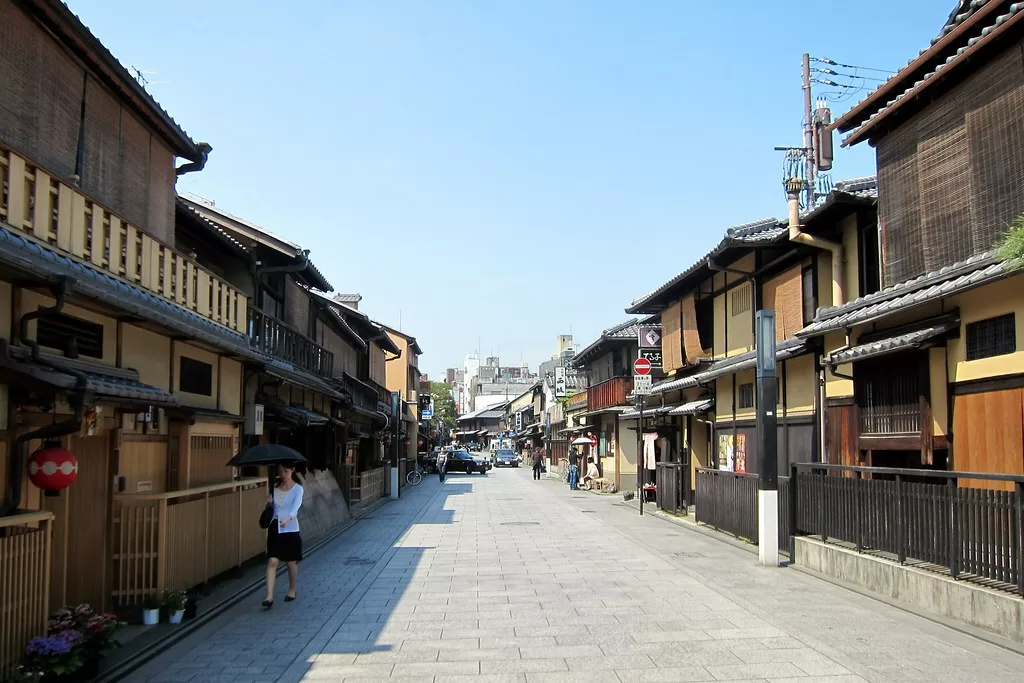
Address:
Gion District does not have a specific address since it is a historic neighborhood in Kyoto. However, the central area of Gion is roughly located near the following landmarks:
Yasaka Shrine 625 Gionmachi Kitagawa, Higashiyama Ward, Kyoto, 605-0073, Japan
How to get there from Kyoto Station:
- Train (Keihan Line):
- From Kyoto Station, take the JR Nara Line (the same line you would use to visit Fushimi Inari Shrine) to Tofukuji Station.
- At Tofukuji Station, transfer to the Keihan Main Line.
- Take a Keihan Line train bound for Demachiyanagi Station.
- Get off at Gion-Shijo Station, which is located in the heart of the Gion District.
- Bus:
- From Kyoto Station, you can also take a Kyoto City Bus to reach Gion. The bus routes that will take you to the Gion area include bus numbers 100, 206, 207, or 208.
- You can ask the bus driver or use a transportation app to confirm the nearest bus stop to your desired destination within Gion.
Activities to Enjoy:
- Geisha and Maiko:
Gion is renowned for its geisha culture. While encounters with geisha are relatively rare and reserved for private engagements, you may be lucky enough to spot them as they move gracefully between teahouses in their elaborate kimono. Maiko, young geisha apprentices, are also a common sight in Gion, identifiable by their distinctive hairstyles and vibrant attire. - Hanamachi:
Gion is part of the hanamachi (flower town), a district where geisha and maiko live and work. Strolling through these charming streets gives you a sense of the traditional atmosphere that has been maintained for centuries. - Yasaka Shrine:
At the heart of Gion lies Yasaka Shrine, a Shinto shrine known for its colorful festivals and traditional architecture. It’s a serene oasis amidst the bustling district. - Shirakawa Canal:
The Shirakawa Canal runs through Gion, and the area along the canal is particularly picturesque, especially during the spring cherry blossom season and in the evenings when lanterns are lit. - Teahouses and Restaurants:
Gion is home to many teahouses and restaurants where you can experience traditional Kyoto cuisine and hospitality. These establishments offer a glimpse into the world of Japanese tea ceremonies and kaiseki dining.
Best Times to Visit:
- Evening:
Gion takes on a special charm in the evening when lanterns illuminate the streets, creating a magical atmosphere. It’s also the time when you might catch a glimpse of geisha and maiko on their way to appointments. - Cherry Blossom Season (Spring):
The streets along the Shirakawa Canal are adorned with cherry blossoms, making this district particularly beautiful in late March to early April. - Gion Matsuri Festival (July):
If your visit coincides with the Gion Matsuri, one of Japan’s most famous festivals, you’ll experience lively parades, traditional music, and a festive atmosphere.
Kinkaku-ji (The Golden Pavilion)
Kinkaku-ji, the Golden Pavilion, is a gem of Kyoto, offering a glimpse into the city’s rich history and aesthetics. Its brilliant exterior, serene garden, and cultural significance make it a destination you won’t want to miss when exploring Kyoto.
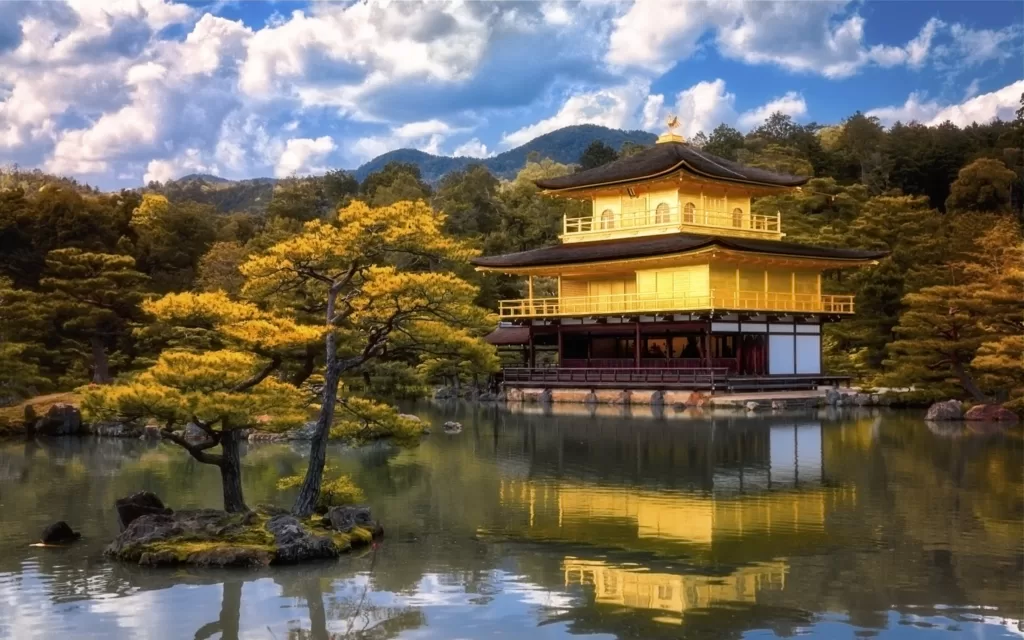
Address:
1 Kinkakujicho, Kita Ward, Kyoto, 603-8361, Japan
How to get there from Kyoto Station:
- Bus:
- From Kyoto Station’s bus terminal, take bus number 101 or 205. These buses are well-marked for Kinkaku-ji.
- The bus ride to Kinkaku-ji takes approximately 30-40 minutes, depending on traffic.
- Taxi:
- Another option is to take a taxi from Kyoto Station to Kinkaku-ji. The ride will be faster, but it will be more expensive than taking the bus.
- Walk and Train (if you enjoy walking):
- If you prefer a scenic route and have some time, you can walk from Kyoto Station to Kinkaku-ji, although it’s a longer journey.
- Start by walking to Kitano-Hakubaicho Station, which is about a 15-minute walk from Kyoto Station.
- Take the Kyoto City Subway Karasuma Line from Kitano-Hakubaicho Station to Kitaoji Station.
- From Kitaoji Station, you can take a bus to Kinkaku-ji or walk for about 15-20 minutes to reach the temple.
Activities to Enjoy:
- The Golden Pavilion:
The main building of Kinkaku-ji is a three-story structure. Each floor is designed in a different architectural style, reflecting the evolving tastes of the shogun. While you can’t enter the pavilion, you can admire its exterior from various viewpoints as you stroll through the garden. - Kyokochi Pond and Garden:
The beautiful Kyokochi Pond reflects the Golden Pavilion and is adorned with small islands, stones, and meticulously arranged trees and plants. It’s a picturesque setting, especially during the fall when the foliage turns vibrant shades of red and gold. - Fudo Hall:
Adjacent to the pond, you’ll find the Fudo Hall, which enshrines the deity Fudo Myoo. This hall also offers a lovely view of Kinkaku-ji. - Teahouse Sekka-tei:
Enjoy a cup of matcha (green tea) and traditional Japanese sweets at the teahouse located near the pond. The teahouse offers a tranquil setting to appreciate the temple and its surroundings. - Hojoki Temple:
On the temple grounds, you’ll also find a small hermitage known as Hojoki Temple, a place where visitors can gain insights into the austere and contemplative aspects of Zen Buddhism.
Best Times to Visit:
- Cherry Blossom Season (Spring):
The temple and garden are especially beautiful when cherry blossoms are in full bloom in late March to early April. - Fall Foliage (Autumn):
Kinkaku-ji is transformed into a world of red and gold during the autumn season, typically in November. The reflections of the trees in the pond create an enchanting scene. - Early Morning:
To avoid crowds, visit Kinkaku-ji early in the morning when it opens to experience the temple and its surroundings in a more peaceful setting.
Higashiyama District
Higashiyama is known for its well-preserved architecture and its connection to the influential Higashiyama culture that flourished during the Muromachi period (14th to 16th centuries). During this time, the district became a hub of arts and culture, contributing to the formation of traditional Japanese aesthetics.
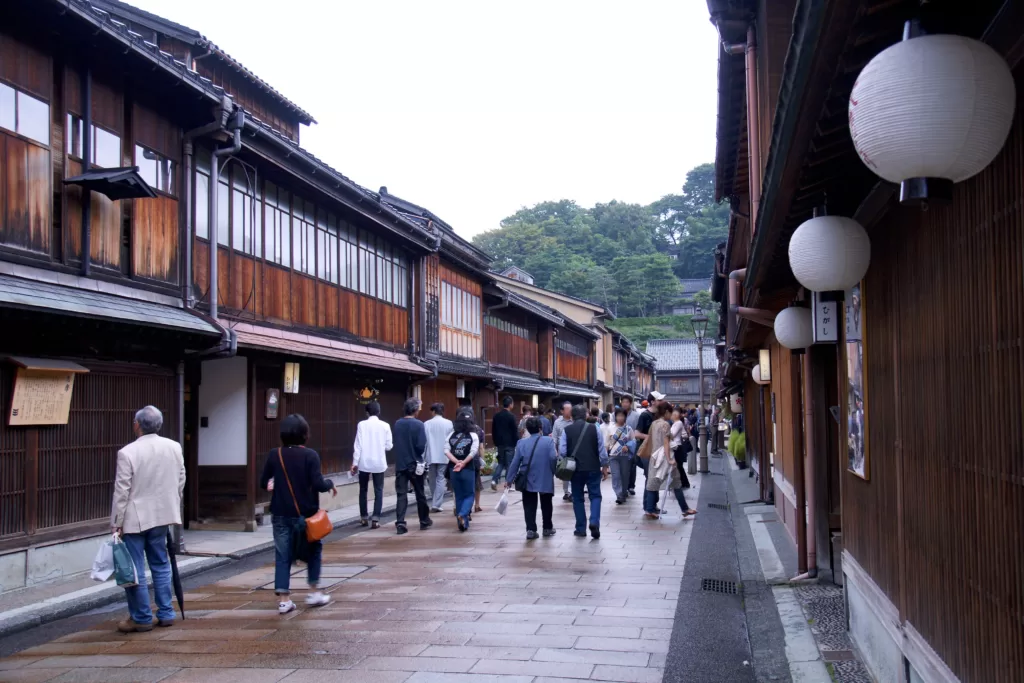
Address:
Higashiyama District doesn’t have a specific address since it’s a historic area within Kyoto rather than a single location. However, you can use these landmarks to navigate the district:
Kiyomizu-Dera Temple: 294 Kiyomizu 1-chome, Higashiyama Ward, Kyoto, 605-0862, Japan
Yasaka Shrine: 625 Gionmachi Kitagawa, Higashiyama Ward, Kyoto, 605-0073, Japan
How to get there from Kyoto Station:
- Bus:
- From Kyoto Station’s bus terminal, you can take several city bus routes to reach Higashiyama. Routes 100, 206, and 207 are commonly used for this journey.
- The exact bus stop you’ll want to get off at in Higashiyama depends on the specific area you’d like to explore within the district. Ask the bus driver for guidance or use a transportation app for real-time information.
- Train and Walk:
- Alternatively, you can take a train from Kyoto Station to the Gion-Shijo Station (a stop on the Keihan Line). This station is located near the Gion District, which is part of Higashiyama.
- From Gion-Shijo Station, you can walk into Higashiyama District. The district’s attractions are within walking distance.
- Taxi:
- If you prefer convenience and privacy, you can take a taxi from Kyoto Station to Higashiyama. Taxis are readily available at the station.
Activities to Enjoy:
- Kiyomizu-dera Temple:
Kiyomizu-dera, a UNESCO World Heritage site, is one of Kyoto’s most famous and historic temples. It offers breathtaking panoramic views of the city and a stunning wooden stage that juts out over a hillside. - Yasaka Shrine:
Yasaka Shrine, also known as Gion Shrine, is a historic Shinto shrine located at the eastern end of Shijo-dori, one of Kyoto’s main streets. It’s known for its annual Gion Matsuri Festival. - Gion District:
Higashiyama seamlessly transitions into Gion, a historic geisha district. You can explore the charming streets, where you might even spot a geisha or maiko (geisha apprentice). - Ninenzaka and Sannenzaka:
These preserved pedestrian streets are lined with traditional teahouses, shops, and restaurants. They offer a nostalgic ambiance and are ideal for strolling and shopping for souvenirs. - Chion-in Temple:
Chion-in is one of the most important temples in Kyoto and is the headquarters of the Jodo-shu sect of Japanese Buddhism. Its massive Sanmon gate is a prominent landmark. - Maruyama Park:
This lovely park, particularly popular during cherry blossom season, is home to the iconic Maruyama Cherry Tree, illuminated at night during the season.
Best Times to Visit:
- Cherry Blossom Season (Spring):
The district is especially beautiful when cherry blossoms are in full bloom in late March to early April. - Fall Foliage (Autumn):
Higashiyama is a spectacular sight during the autumn season, typically in November when the foliage turns vibrant shades of red and gold. - Morning:
To explore the district in a quieter and more peaceful atmosphere, visit in the morning when it’s less crowded
Kyoto Imperial Palace Park
The imperial palace was the residence of the Japanese emperor for over a millennium, from 794 to 1869 when the capital moved to Tokyo (formerly Edo). It offers visitors a glimpse into the country’s imperial past, surrounded by meticulously maintained gardens and scenic landscapes.
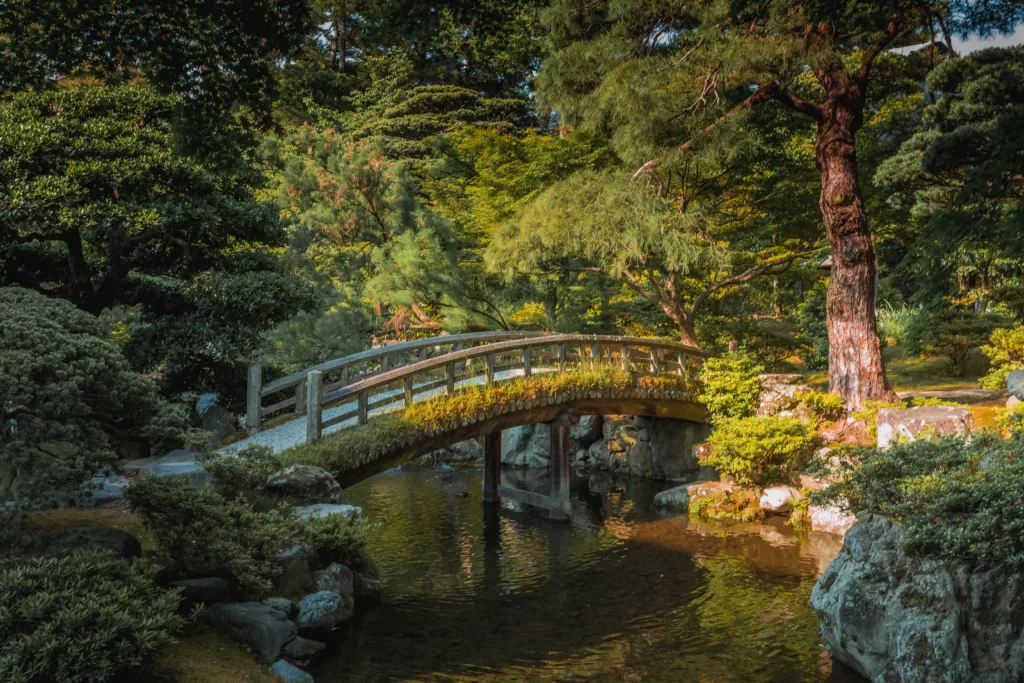
Address:
3 Kyotogyoen, Kamigyo Ward, Kyoto, 602-0881, Japan
How to get there from Kyoto Station:
- Bus:
You can take a city bus from Kyoto Station to the “Imadegawa-Dori Horikawa” bus stop, which is close to the Kyoto Imperial Palace Park. City bus routes 9, 50, 101, 203, or 204 will take you there. - Subway and Walk:
Alternatively, you can take the Karasuma Line from Kyoto Station to Imadegawa Station. From there, it’s about a 15-minute walk to the park.
Activities to Enjoy:
- Imperial Palace Buildings:
While you can’t enter the main buildings of the Kyoto Imperial Palace, you can participate in guided tours offered by the Imperial Household Agency to explore the beautiful exteriors and learn about history and architecture. - Kyoto Imperial Palace Gardens:
The palace grounds feature stunning gardens, including the Sento Imperial Palace Garden and the Omiya Imperial Palace Garden. These gardens showcase traditional Japanese garden design and offer a serene escape in the heart of the city. - Cherry Blossom Viewing:
The park is particularly beautiful during the spring cherry blossom season, typically from late March to early April. The Sakura trees create a stunning backdrop for a leisurely stroll or a hanami (cherry blossom viewing) picnic. - Seasonal Beauty:
Each season offers its own unique charm. In autumn, the foliage turns vibrant shades of red and gold, making it a lovely spot for koyo (fall foliage) viewing. - Honmaru and Ninomaru Palaces:
Explore the Honmaru and Ninomaru Palaces, both of which are important structures within the palace complex and showcase traditional Japanese architecture and aesthetics.
Best Times to Visit:
- Cherry Blossom Season (Spring):
Late March to early April is the most popular time due to the cherry blossoms. - Autumn Foliage (Autumn):
November is ideal for colorful foliage. - Morning or Weekdays:
To avoid crowds, consider visiting in the morning or on weekdays.
Kiyomizu-Dera Temple
Kiyomizu-Dera, officially known as Otawa-san Kiyomizu-dera, has a rich history dating back to the 8th century. The temple was founded during the early Heian period and has since played a central role in Japanese Buddhism. Its name, Kiyomizu-dera, translates to “Pure Water Temple,” referring to the Otawa Waterfall within the temple grounds, known for its pure and clear waters.
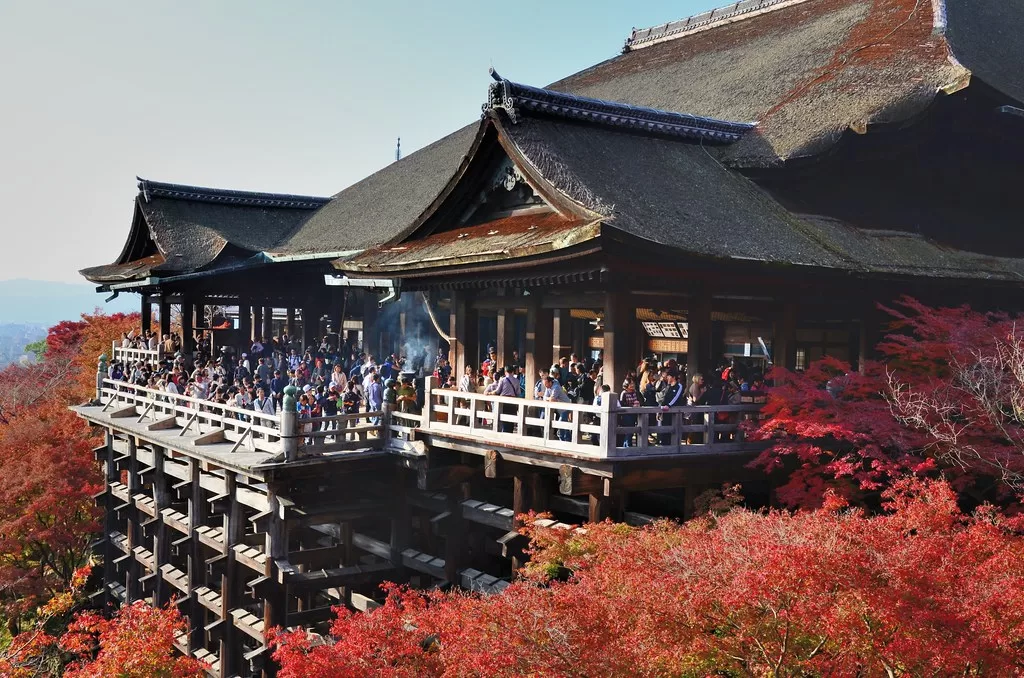
Address:
294 Kiyomizu 1-chome, Higashiyama Ward, Kyoto, 605-0862, Japan
How to get there from Kyoto Station:
- Bus:
- From Kyoto Station’s bus terminal, take bus number 100 or 206, which are well-marked for Kiyomizu-dera.
- The bus ride to Kiyomizu-dera takes approximately 15-20 minutes, depending on traffic.
- Taxi:
- Alternatively, you can take a taxi from Kyoto Station to Kiyomizu-dera. It’s a more direct and faster option, but it may be more expensive than taking the bus.
Activities to Enjoy:
- Kiyomizu Stage:
The Kiyomizu Stage provides a magnificent viewpoint, offering an unobstructed vista of the city and surrounding nature. The surrounding cherry and maple trees create a stunning backdrop during the changing seasons. - Main Hall:
The temple’s main hall is an architectural masterpiece, characterized by its intricate woodwork and traditional design. Visitors can explore the interior and admire the temple’s religious and artistic elements. - Jishu Shrine:
Located within the temple complex, Jishu Shrine is dedicated to the deity of love and matchmaking. Here, you can participate in a fun and romantic ritual of walking between two stones with your eyes closed to find love. - Otawa Waterfall:
The Otawa Waterfall is a sacred spot where visitors can catch and drink the pure spring water believed to have healing properties. You can use long-handled cups to collect the water. - Cherry Blossom and Fall Foliage Viewing:
Kiyomizu-Dera is particularly beautiful during the cherry blossom season in late March to early April and during the autumn foliage season in November when the surrounding trees burst into vibrant colors.
Best Times to Visit:
- Cherry Blossom Season (Spring):
Late March to early April is the peak time for cherry blossoms, making it one of the most popular times to visit. - Fall Foliage (Autumn):
The temple is spectacular in November when the foliage turns vibrant shades of red and gold. - Morning or Weekdays:
To avoid crowds, consider visiting in the morning or on weekdays.
Nijo Castle
Nijo Castle, also known as Nijo-jo, was constructed in the early 17th century by Tokugawa Ieyasu, the founder of the Tokugawa Shogunate, which ruled Japan for over two centuries. The castle was intended to serve as the Kyoto residence for the Tokugawa shoguns when they visited the imperial capital.
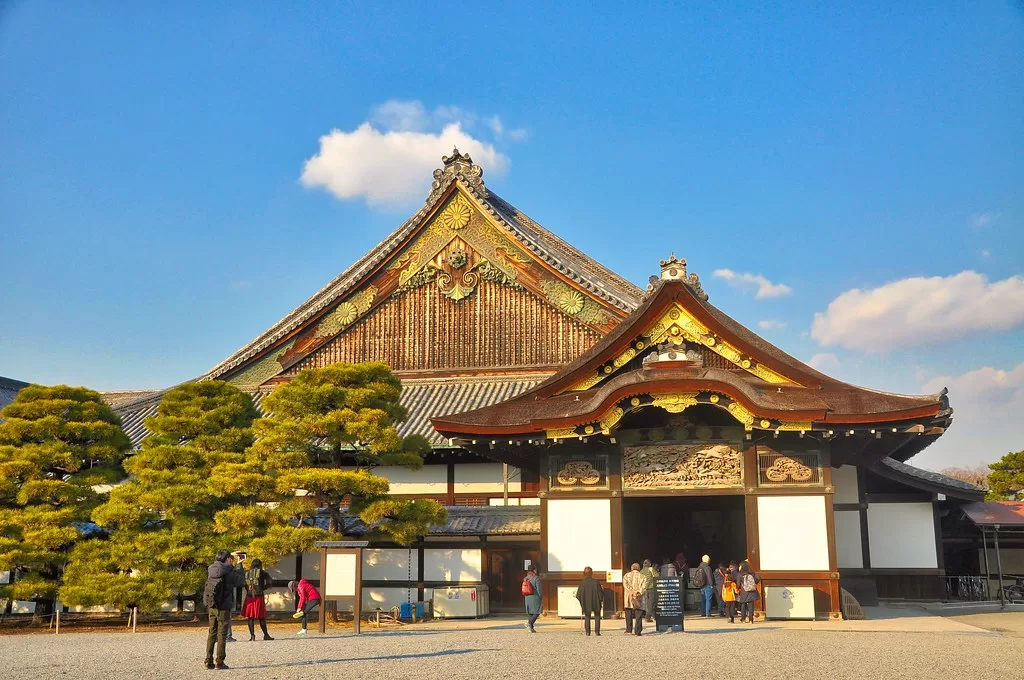
Address:
541 Nijojocho, Horikawa-Nishiiri, Nijo-dori, Nakagyo Ward, Kyoto, 604-8301, Japan
How to get there from Kyoto Station:
- Bus:
- From Kyoto Station’s bus terminal, take bus number 9, 50, or 101 to reach the Nijo Castle (Nijo-jo Mae) bus stop. The bus ride takes approximately 15-20 minutes.
- Train and Walk:
- If you prefer to take the train, you can take the JR Sagano Line from Kyoto Station to Nijo Station. From there, it’s about a 10-minute walk to Nijo Castle.
- Taxi:
- A taxi ride from Kyoto Station to Nijo Castle is a convenient and relatively quick option.
Activities to Enjoy:
- Honmaru Palace:
The centerpiece of Nijo Castle is the Honmaru Palace, a beautifully designed structure known for its “nightingale floors.” These floors are designed to chirp like birds when walked upon, serving as a security measure against intruders. The palace is adorned with exquisite sliding doors, painted screens, and intricate artwork. - Ninomaru Palace:
The Ninomaru Palace is another notable building within the castle complex. It features stunningly decorated rooms, each showcasing the distinctive aesthetics of the Edo period. The artwork and interior design of this palace are a feast for the eyes. - Ninomaru Garden:
Surrounding the Ninomaru Palace is a lovely garden with cherry and plum trees, ponds, and walking paths. It offers a serene environment that complements the beauty of the palace. - Moat and Walls:
The castle is encircled by a massive stone wall and a wide moat, making it an impressive defensive structure. You can walk along the outside of the moat for picturesque views of the castle. - Cherry Blossom Viewing:
Nijo Castle is particularly popular for cherry blossom viewing during the spring season, typically from late March to early April. The castle’s gardens come alive with colorful blooms, attracting visitors from all over.
Best Times to Visit:
- Cherry Blossom Season (Spring):
Late March to early April is a fantastic time to visit when the cherry blossoms are in full bloom. - Fall Foliage (Autumn):
November is ideal for experiencing koyo (fall foliage) when the trees around the castle turn vibrant shades of red and gold. - Morning or Weekdays:
To avoid crowds, consider visiting in the morning or on weekdays.



